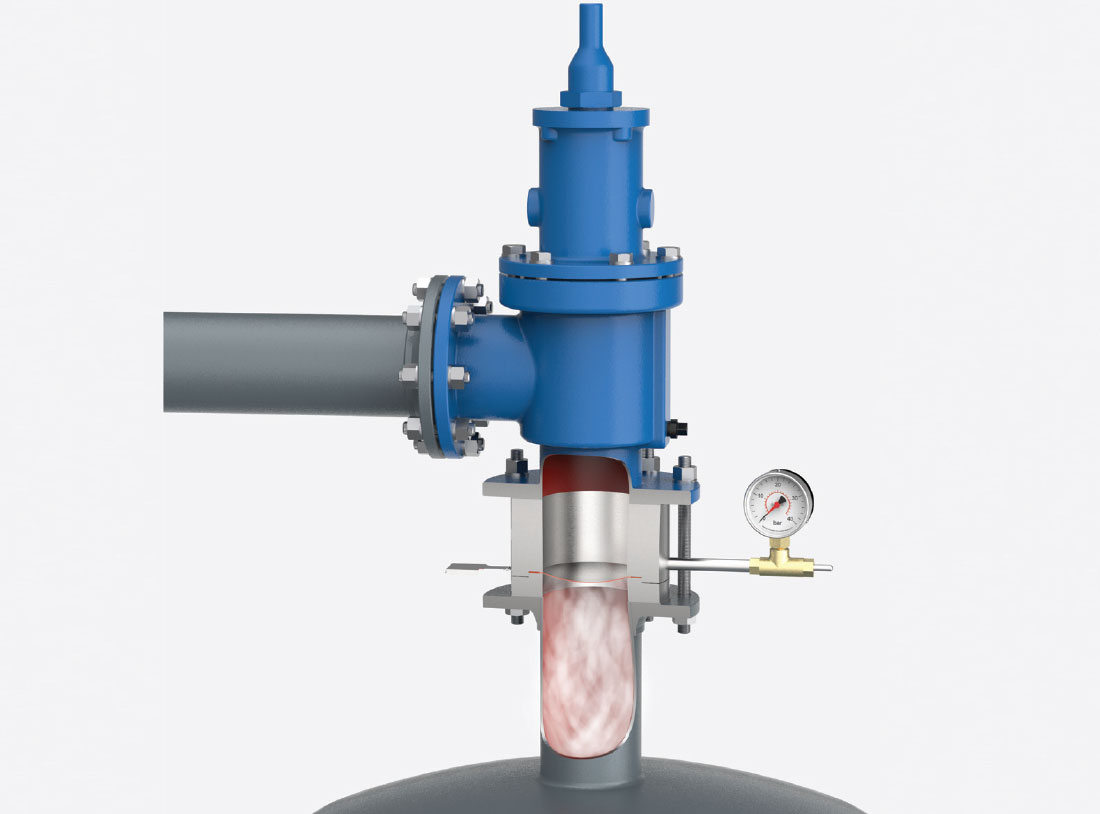Emission control is essential to protect employees, communities and the environment from harmful chemical leaks and to protect the business from significant fines.
By Michael Hunt, Business Development Manager, Fike

While a certain level of fugitive emissions is allowable, various governmental agencies, including the European Emissions Trading System (EU ETS) and the US Environmental Protection Agency (EPA), impose fines for emission levels above acceptable limits. Furthermore, these fines are publicised, which may negatively impact the company’s public image at local, national, and global levels.
Most industrial processing companies and their operators seek to implement simple, non-invasive methods to control their emissions to avoid these consequences.
Isolation of leaking pressure relief valves
One of the most common emission sources throughout the processing industry is pipe connections through the use of flanges and gaskets. Improper design and installation, incorrect selection of gasket materials and bolting, and general wear and tear of these connections are causes of potential fugitive emissions.
However, another often overlooked source of emissions is the leakage or ‘weeping’ of process media through pressure relief valves. Most spring-operated pressure relief valves rely on special metal-to-metal sealing surfaces to achieve leak tightness. Inevitably, some leakage occurs as the operating pressure approaches the valve’s set pressure. Leakage also occurs over time as valve components wear, and leakage causes more wear, leading to increasing leakage rates.
Rupture discs
Many industrial processing companies have found that an effective way of reducing overall leakage is by installing rupture discs upstream of pressure relief valves.
Rupture discs, or bursting discs, are effectively leak-tight, single-use metallic pressure relief devices engineered to open when the process pressure reaches the disc’s set burst pressure. In these upstream assemblies, the process media only reaches isolated pressure relief valves when the rupture disc activates. The combination of pressure relief valves and upstream rupture discs will largely eliminate the continuous emissions from the valve. At the same time, the safety of the installation against over-pressure conditions remains at the required level.
Additional benefits of upstream rupture discs
In addition to emission control, installing rupture discs upstream of pressure relief devices may improve the total cost of ownership of expensive pressure relief valves. Because pressure relief valves are then isolated from normal process flow, they are also protected from corrosive or viscous media, often resulting in less cleaning, maintenance, downtime and less expensive valve trim.
Finally, upstream rupture discs will extend the service life of pressure relief valves, reducing the loss of production time needed for removal and re-assembling of the device. This is possible because the added rupture disc allows for ‘in-situ’ testing of the pressure relief valve (without the need to uninstall it) by demonstrating its unchanged performance. A limited volume is created between the rupture disc and valve inlet, where isolated pressure may be introduced to measure and register as evidence of acceptable valve performance.
Considerations for selecting and installing rupture discs
Several measures must first be considered to safely realise the benefits of installing rupture discs upstream of pressure relief valves.
The rupture disc should not impede or interfere with the operation of the pressure relief valve. To achieve this, the rupture disc must be ‘non-fragmenting,’ so upon activation, loose parts do not enter the valve and obstruct the orifice or restrict the valve from closing. Also, a sufficient distance between the rupture disc and the valve seat is required to prevent obstruction. However, the rupture disc must still be installed close enough to the valve (a maximum of five pipe diameters away) to avoid the creation of reflective pressure waves during the opening of the disc, which could result in the re-closing of the disc or even fragmentation.
When installing rupture disc devices upstream of relief valves, the size of the rupture disc should be at least the same nominal size as the inlet of the relief valve. Additionally, the rated relief capacity of the valve, as stated by the manufacturer, is to be reduced by 10 percent, or reduced to the certified combination capacity value (where the specific combination has been capacity tested and certified by a recognised third party).
Finally, the set pressure of the rupture disc device is typically set at the same pressure as the PSV, which itself is set in accordance with the applicable legislative standards and guidelines. ASME UG-132 and EN ISO4126-3 differ very slightly, however, the basic guidance is the same and keeping the RD specified burst pressure and PRV set pressure at the same nominal value ignoring rupture tolerances, meets the intent of each of the standards and is relatively easy to implement. This can be achieved by specifying an RD with a Zero (+/-0%) manufacturing range (ASME), or +/- Performance Tolerance (EN ISO).
Non-invasive, cost-effective
An industrial process’s total emissions extend beyond leaks from pressure relief valves. However, installing rupture discs upstream from pressure relief valves is a relatively non-invasive and cost-effective process that many industrial processes have implemented to play a key role in their overall emission control strategy.
About the author
 Michael Hunt has worked in pressure relief for almost 30 years across Europe, South Africa and the Far East. He has extensive experience working in both direct sales and via a network of distributors for manufacturers of instrumentation and pressure relief devices servicing the petrochemical, oil & gas, chemical, pharmaceutical, OEM and power generation markets.
Michael Hunt has worked in pressure relief for almost 30 years across Europe, South Africa and the Far East. He has extensive experience working in both direct sales and via a network of distributors for manufacturers of instrumentation and pressure relief devices servicing the petrochemical, oil & gas, chemical, pharmaceutical, OEM and power generation markets.
About this Featured Story
This Featured Story is an article from our Valve World Magazine November 2022 issue. To read other featured stories and many more articles, subscribe to our print magazine. Available in both print and digital formats. DIGITAL MAGAZINE SUBSCRIPTIONS ARE NOW FREE.
“Every week we share a new Featured Story with our Valve World community. Join us and let’s share your Featured Story on Valve World online and in print.”



